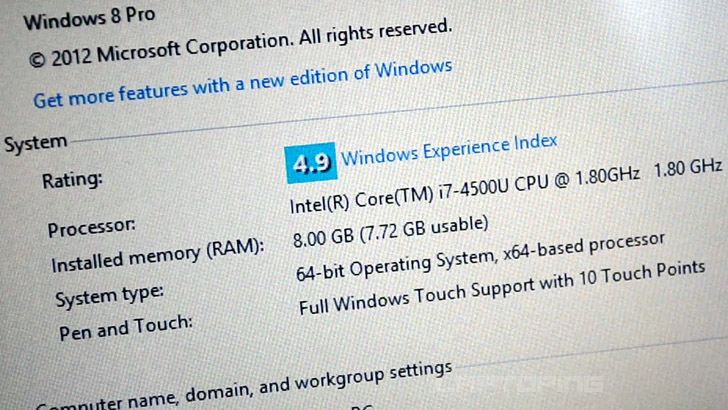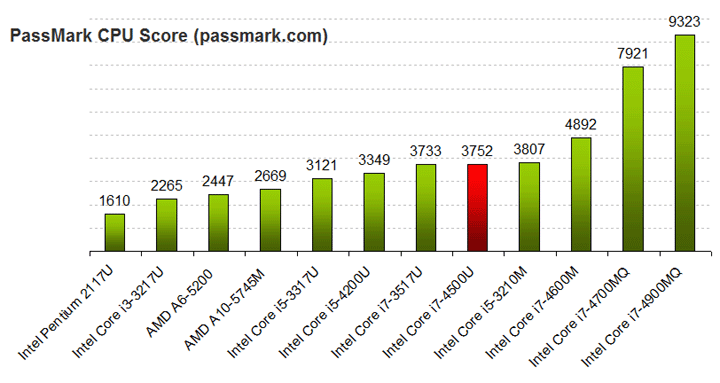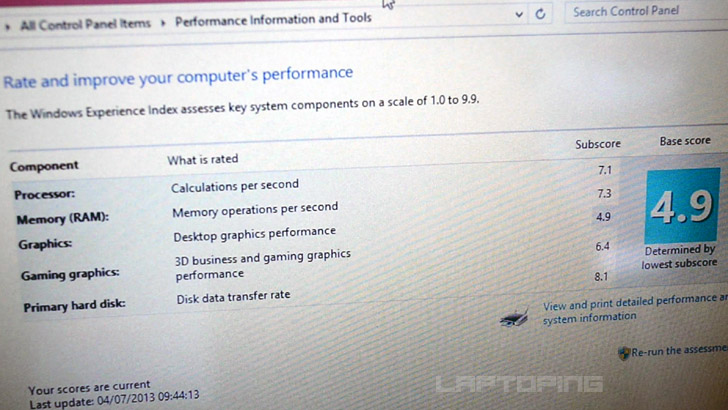The Intel Core i7-4500U dual-core processor sits on the top of the 2013 4th Generation Intel Core “Haswell” ultra-low voltage lineup and is currently the fastest chip specially made for ultrabooks.

But, it’s not as fast as the full-voltage i7 (4th Gen i7-4600M dual-core, i7-4700MQ / 4700HQ quad-core and other), designed for high-performance and gaming laptops. That’s not a surprise, since the i7-4500U is optimized for power efficiency and low heat, which are both very important for ultrabooks and other portability-centric thin-and-light laptops. The trade-off is a lower computing speed.
You can see that in the chart below, but keep in mind that the ULV i7 consumes 15 Watts, while the full voltage parts consume 37W or more, which makes a huge difference when it comes to battery life of a laptop.

Among the showed CPUs, the most interesting comparison is against the Intel Core i5-4200U. It’s one step below the i7-4200U in the hierarchy. Everything else being equal, laptops with the i5-4200U are roughly $100 cheaper than those with i7-4500U. Choice between the two depends on tasks the user will do. In everyday web surfing, office document creation, and multimedia playback, you’ll hardly notice any difference in speed. The i7 may come handy in some more complex scenarios, such as ediging of large photos, video editing, or file compression and decompression. So, if you plan to do a lot of these, the i7 is a way to go. Other users will be fine with the i5. Both CPUs have the same Intel HD 4400 integrated graphics, so difference in 3D games rendering will be minor, in a slight favor of the i7 because of better main CPU specs.
When it comes to Intel’s only competitor in the notebook arena – AMD, the comparable A10-5745M lags significantly behind the overviewed chip in the processor benchmark, but AMD’s solution for thin-and-light laptops has better integrated graphics. You can learn more about it in the AMD A10-5745M / Radeon HD 8610G overview.
On the end, here’s Windows Experience Index score of the i7-4500U. It has slightly higher CPU (7.1) and gaming graphics (6.4) performance than the i5-4200U. For some reason, Desktop Graphics Performance on the machine we tested scored weirdly low 4.9, maybe because of some driver or software problem. (It’s 5.8 on the i5.)

Quick Specifications: Intel Core i7-4500U dual-core; 4th Generation Core “Haswell” family; Intel HD 4400 grpahics; 1.8GHz default, up to 3.0GHz with TurboBoost 2.0; 4MB cache, 15W TDP; 22-nanometer production process; 1600MHz DDR3 RAM support

hi ! i want to now the graphics performance (photoshop cc , illustrator cc , After effect cc …) in this i7 4500U ? 1.8 ghz i think is too low for graphics softwares ?
And thanks! :)
I haven’t tested these programs, but can tell you you’ll hardly find a better mainstream laptop CPU for these apps than the i7-4500U / i7-4510U. Exceptions are the i7-4500M/4510M dual-core or for ultimate performance the quad-core i7-4700/4800/4900 MQ/HQ series. The M-series and MQ / HQ consume much more power and run hotter than the U-series and therefore are rarely used in thin and light notebooks.
By the way, the i7-4500U can run at up to 3GHz. The 1.8GHz is a base clock speed, which increases up to 3GHz if needed thanks to TurboBoost technology.